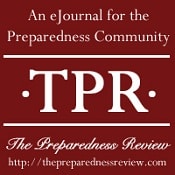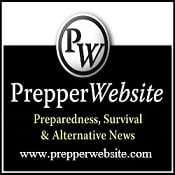Types of Floods
I don’t need to tell you how dangerous flooding can be. Floods are the most common natural disaster in the United States. Whether it is extreme or minor, flooding can wreak havoc on your life.
Below, we will guide you on how to be prepared for a flood, when to evacuate, and how to get your life back together after a flood.
I would love for you to join my Food Storage Moms Facebook group if you’re interested. Food Storage Moms
When it comes to floods, there are two different types of floods that can be a problem. They are flash floods and river floods. Flash floods usually take more lives, whereas river floods cause a loss of property.
A flash flood is when runoff from excessive rainfall causes a rapid rise in water height. If you live in an area that is dry or has a rocky terrain, you are more susceptible to a flash flood. This is because there is a lack of soil or vegetation to absorb the water.
If you live next to a large river, river flooding is common. The river can rise and cause flooding when there are long-lasting rainstorms, a lot of melting snow, ice jams, or high tides.
Knowing what types of floods can happen in your area is a great way to begin to prepare for a flood before it happens.
Did you know that only six inches of moving water can knock you off your feet? The issue with flooding is not only that there is water standing in an ear, but the bigger problem is that it moves, taking people, animals, and property along the way. Here are some things you need to know:
Even if you live in an area that gets minor flooding, you can still deal with the effects of a power outage, roads being blocked off, and the inability to make it to the store safely. Thus, you should be prepared for a flood or any natural disaster at home. Here are some ways you can prepare for flooding before it happens:
Do you live in an area that floods easily? What kind of flooding risk do you have in your area? You can visit FEMA’s Flood Map Service Center to get information about flooding in your area. This will help you to know what risks you have. If you have a flash flooding risk, be sure to monitor potential signs, such as a lot of rain over an extended period.
You can sign up to get emergency weather alerts on your phone. Sign up for your community warning system. You can also find out about emergency alerts from the Emergency Alert System and National Oceanic and Atmospheric Administration on the radio. It’s a great idea to have a solar-powered radio.
When you purchase insurance for your home, it doesn’t generally include flood insurance. Check with your insurance company to ensure you have flood insurance if you are in a high-risk area. If you don’t you will want to purchase it separately if you live in a high-risk area. You can get flooding insurance under the National Flood Insurance Program.
Because you could be without power or the ability to get to the store for a few days to several weeks, you should stock up on things you will need. This includes:
Documents such as your flood insurance policy, birth certificates, social security cards, and other important information should be kept in a waterproof container. Additionally, you can create an Important Documents Emergency Binder so you can grab it when you need it.
In many cases, evacuation is the only option. So, before you get to the point where you have to evacuate, know the routes you would take. Make a plan with members of your household as to where you would go, what you would do, and how to get everyone to a safe location.
If you live in an area where flooding can get bad quickly, you should have your car ready for evacuation. Check out Car Survival Items Needed in your vehicle so you are prepared for the event of an evacuation.
If you are told to evacuate, do so immediately. You would not have an evacuation warning if everything was ok. If you are told to evacuate, here are some things you need to know:
After the flood, you will want to inspect your home, your property, and see if there is any damage that has been done. If there is damage, be sure to take pictures and call your insurance company right away. Getting your life back together will happen one day at a time. Begin by cleaning up what you can, calling your insurance company, and getting food and water supplies.
Once the flood has subsided, authorities will release information and instructions for returning home. Being prepared makes it so much easier to get out during a flood and be protected. Once the risk of flooding is over, here are some things you need to know:
Are you prepared for a flood in your area? Share the steps you have taken to prepare for a natural disaster in the comments below! May God bless this world, Linda
Copyright Images: Flooding Depositphotos_8149991_s-2019
Aw, Linda, if only the younger ones paid attention…I simply ‘force’ my car preps into theirs, tho both have used my car preps over the yrs. My roadside assistance was declined as part of our insurance policy this year. Now, that has to do with only usage, whatever. But, I’ve tried to teach my younguns how to stay alive. Oh,and then,apply for mncare?
Hi Wendy, what is mncare? Your roadside assistance was declined, wow???? Linda
My roadside assistance coverage was discontinued due to last yrs claims for one winter! Yes, I was irritated as we had only made one other in over 10 yrs of paid coverage. Then came last winter! I think we did 6. My co is Nationwide. To me, why offer this as a benefit when they can cancel if a person uses it? Anyway…as to mncare/sure, my home state had Obamacare but better decades before he took office. Um, no, we can’t have people moving here for this. I wish the people in Congress would use MN as an example of health care for everyone.
Hi Wendy, wow!! I would be irritated as well. The last few years have been brutal as far as weather. I agree with you on health care. I have heard about MN healthcare, great comment. I doubt we can get Congress to listen, just my two cents. Linda
Your email address will not be published. Required fields are marked *
I’m Linda Loosli. I’m the owner and editor of Food Storage Moms. I’m so happy you’ve found us. Our goal at Food Storage Moms is to help “one family at a time.”
Download my FREE Emergency Binder.
This Site is affiliated with CMI Marketing, Inc., d/b/a CafeMedia (“CafeMedia”) for the purposes of placing advertising on the Site, and CafeMedia will collect and use certain data for advertising purposes. To learn more about CafeMedia’s Privacy Policy, click here.
Food Storage Moms, LLC is a participant in the Amazon Services LLC Associates Program, an affiliate advertising program designed to provide a means for sites to earn advertising fees by advertising and linking to Amazon.com.
Types of Floods
Research & References of Types of Floods|A&C Accounting And Tax Services
Source




0 Comments